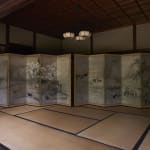Horses in Landscape
Color on paper, pair of six-panel folding screens
Mid 16th century
171 x 380 cm each (overall)
Mid 16th century
171 x 380 cm each (overall)
Further images
Literature
Sojuga: Ryuko enko. Vol. 16, Nihon byobu-e shusei. Tokyo: Kodansha, 1978.
This pair of folding screens is published in the Nihon Byobu-e-shusei, or Survey of Japanese folding screens, volume 16. According to the description of the work by Wakisaka Jun, this work may be executed by “the third generation of Unkoku Togan.” Two lying face-up horses are painted in the right screen; a similar example can be observed in a copy of Bamo-doi-zukan, a handscroll by Kano Sansetsu in the Stibbert Museum. In the left screen, a horse is standing and rubbing its neck against a tree. Likewise, the same posture can be seen both in Sanraku Sansetsu sansui-jo, or an album of small sketches, and Yosa Buson’s Wild Horses in the Kyoto National Museum; the latter one arguably follows the style of Shen Quan. The prototype of the horses in the present work perhaps derives from the Chinese originals. The strong verticality seen here is also the characteristic of Sanraku, Sansetsu and Unkoku school; yet, the linear expression on the rock appears softer than those executed by the painters active in the beginning of the Early Modern period, which may suggest that this work was done by painters earlier. Another example is Landscape of the Four Seasons, a pair of folding screens in the Metropolitan Museum of Art, attributed to a pupil of Motonobu, in which the depicted rocks show the strong verticality. Also, the similar diamond-shaped rocks can be found in Metropolitan screens. Those similarities, the portrayal of figures and the firm expression of clothing lines in the style of Motonobu, reinforce that the present work may be done by someone who was in close proximity to Motonobu.







